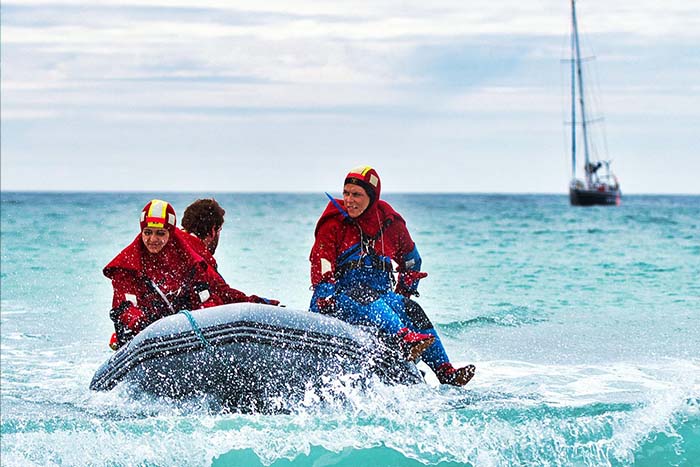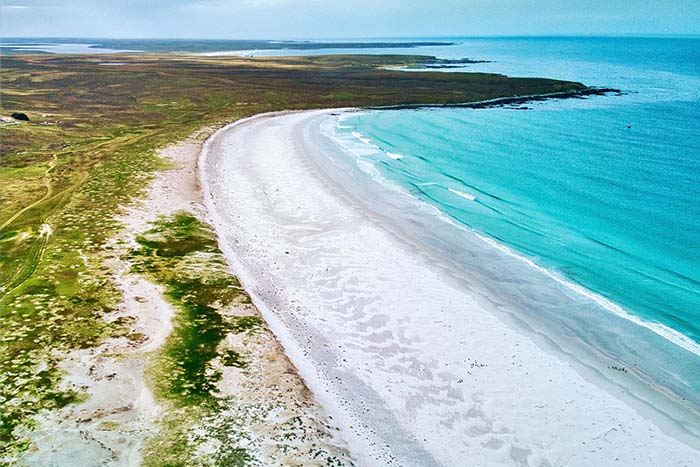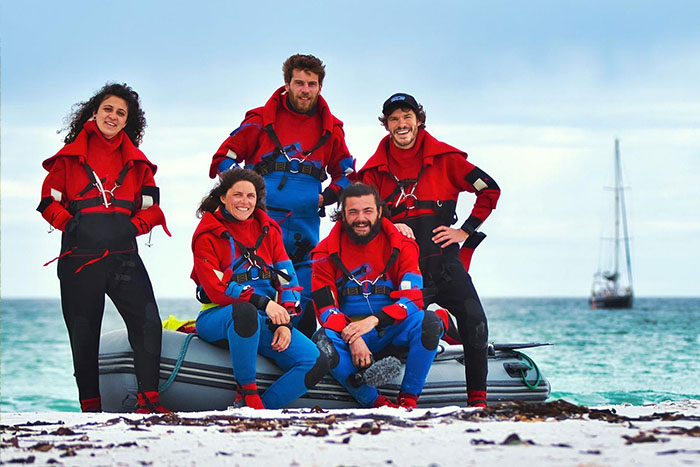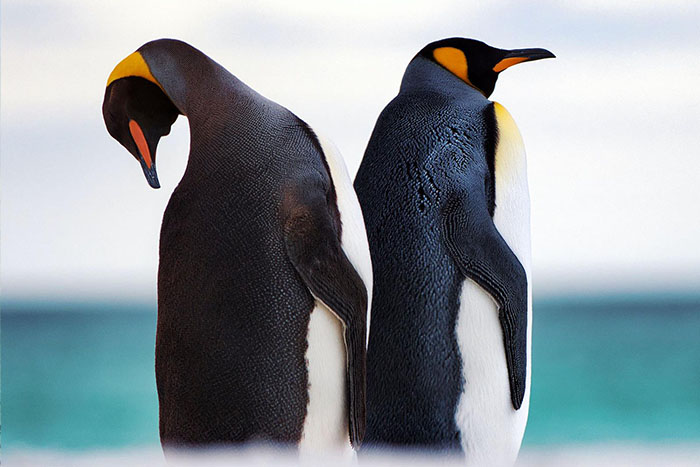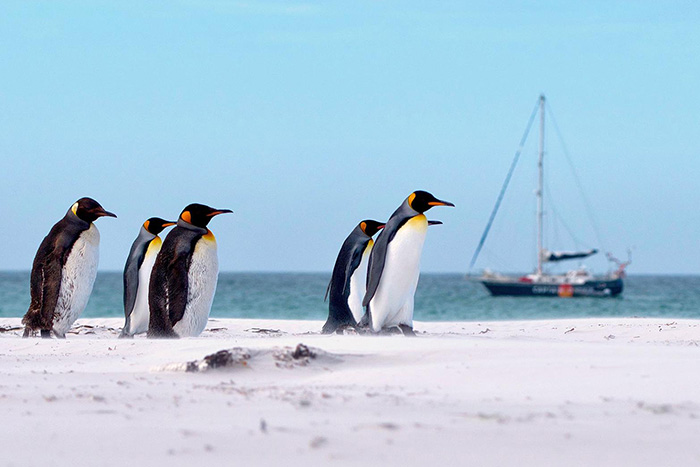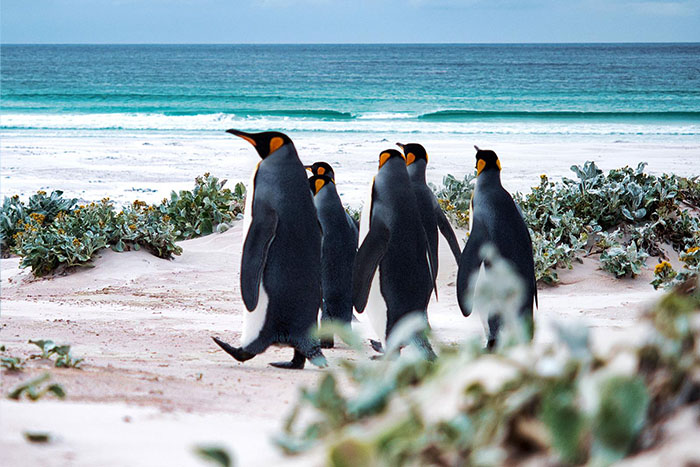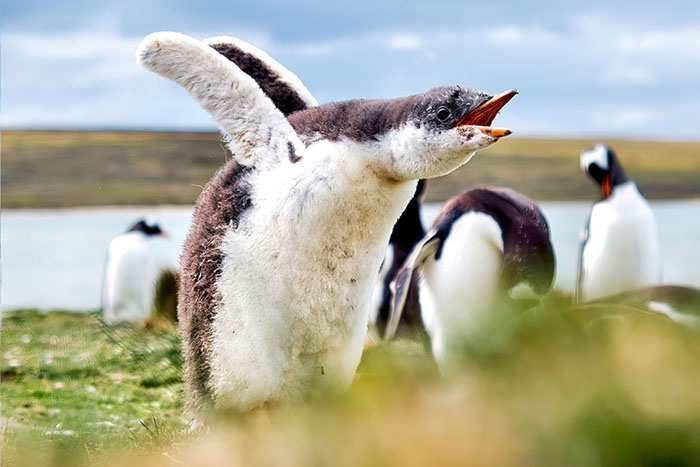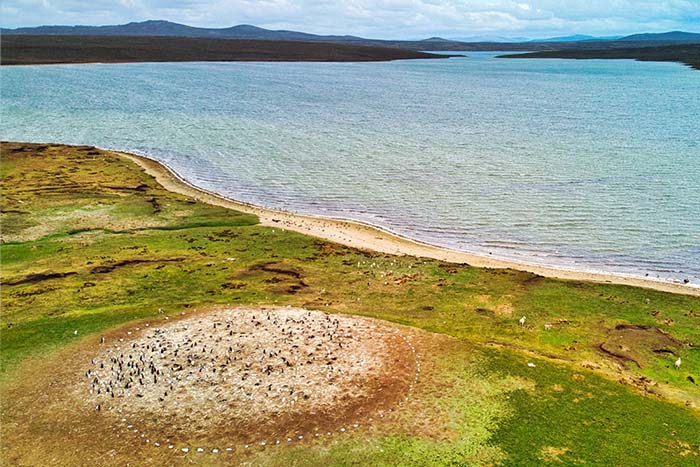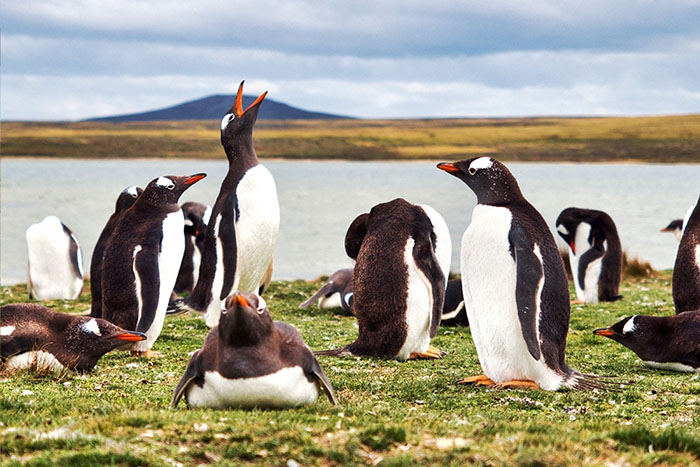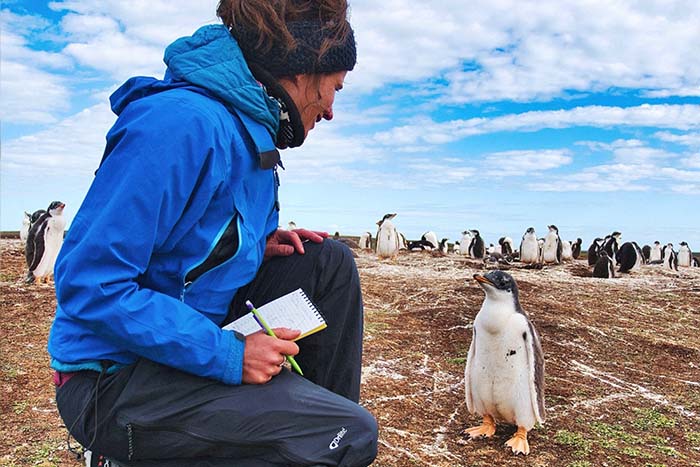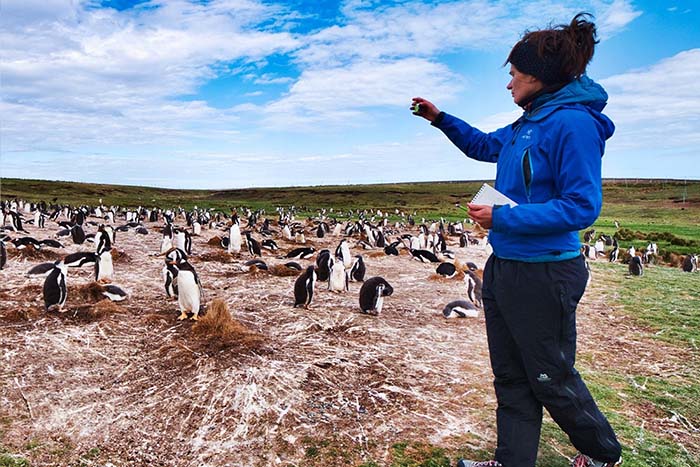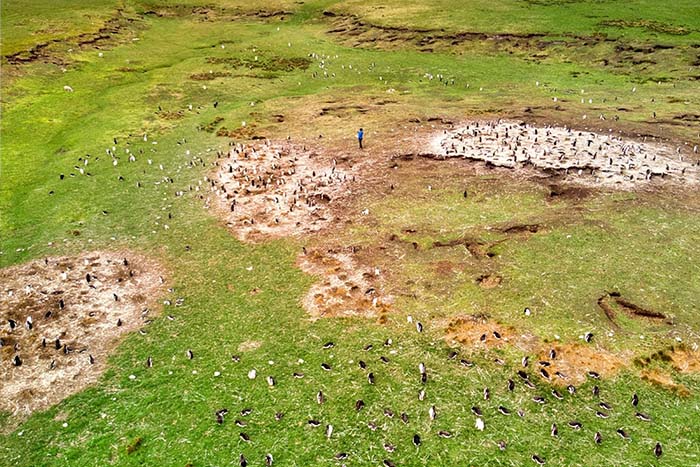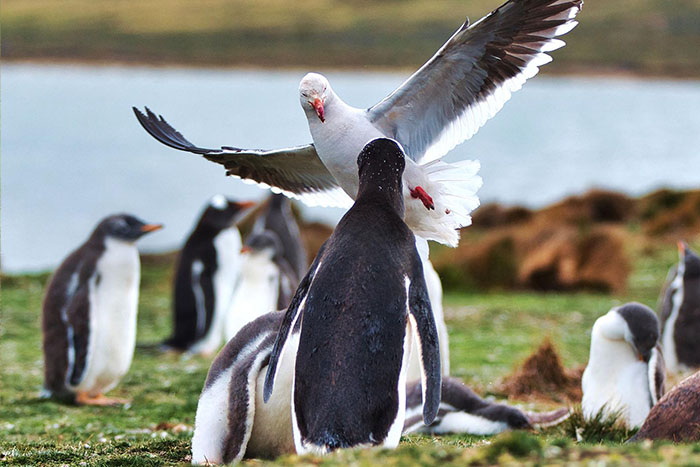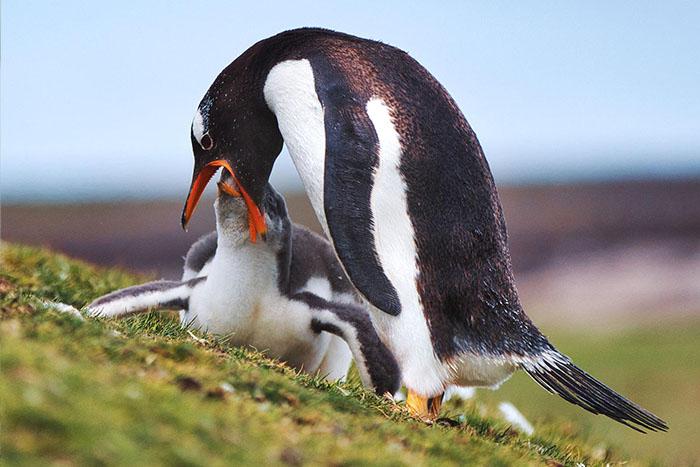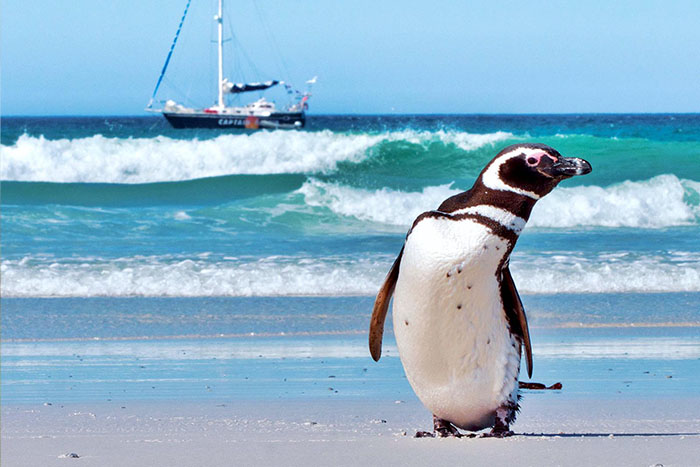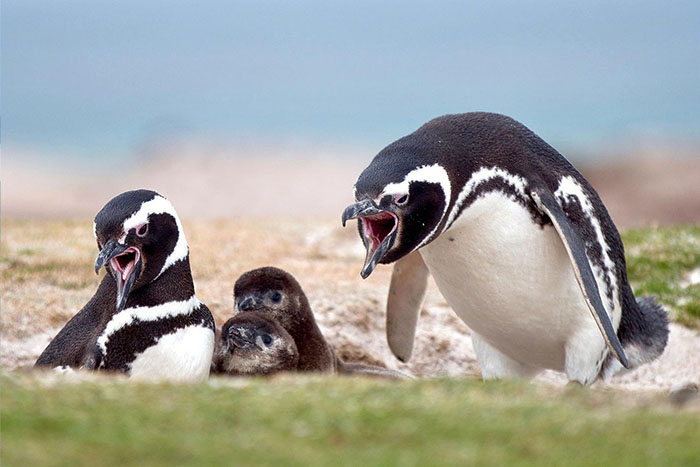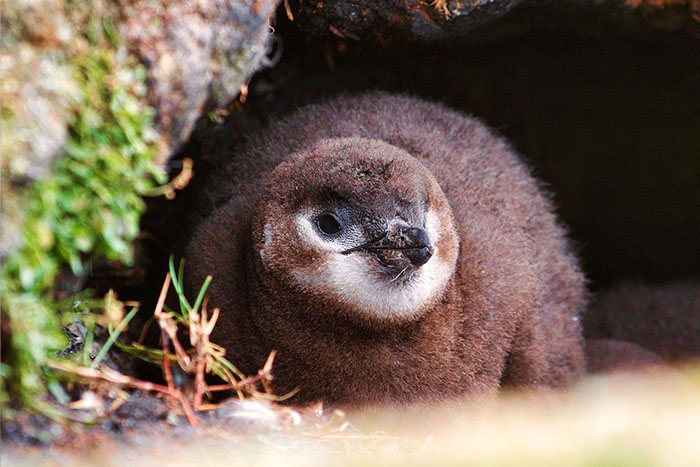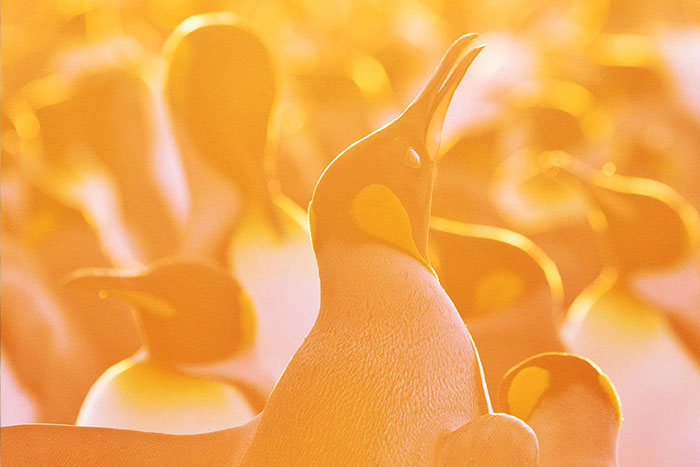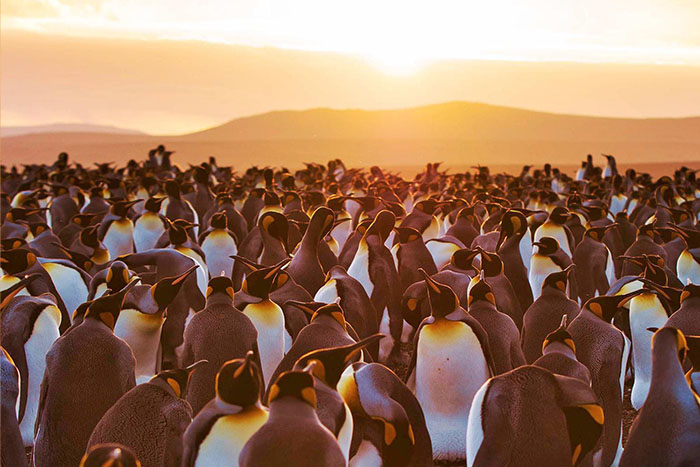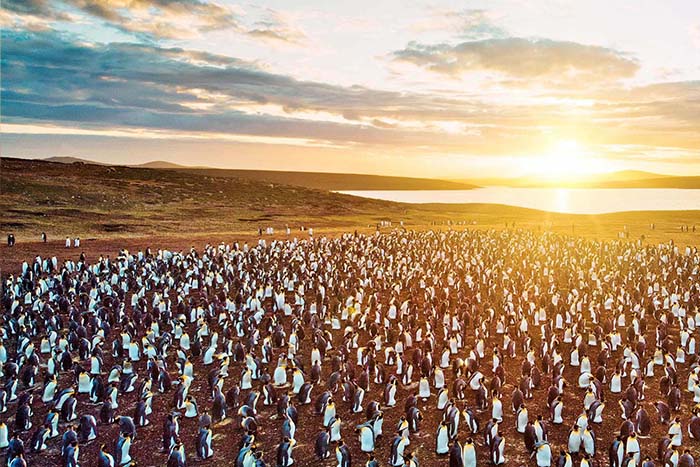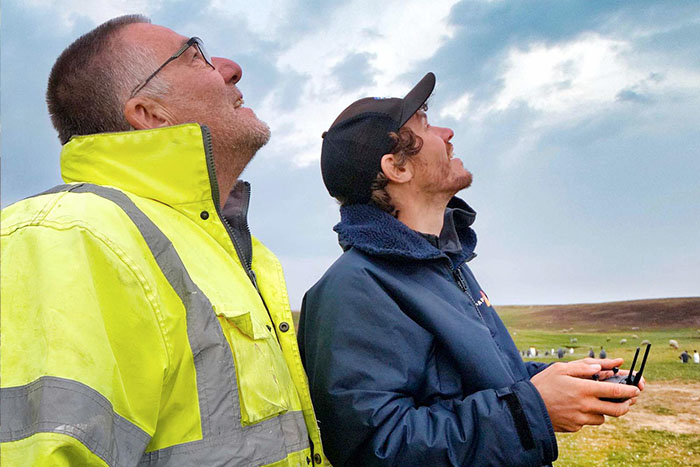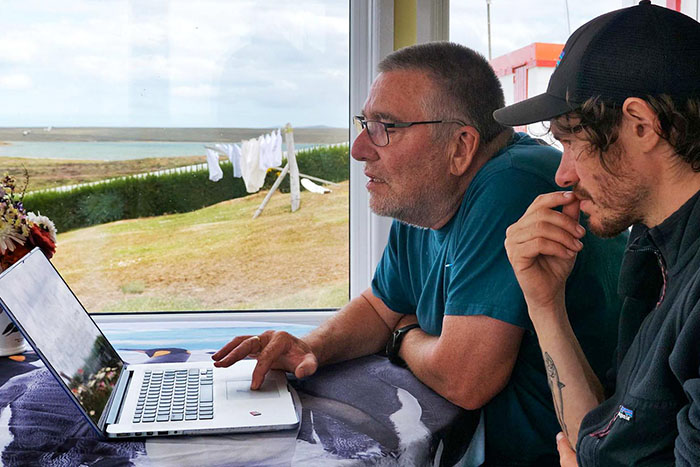Biodiversity Evolution⎢Falkland Islands⎢2023
The penguins
of Volunteer Point
In partnership with Falkland Conservation

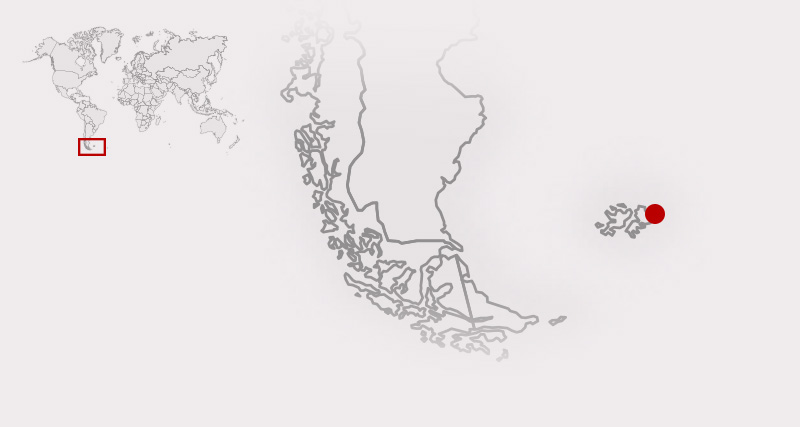
In March 1833, upon his arrival in the Falklands, Darwin was quick to encounter the fascinating Magellanic penguin, carefully observing their curious mannerisms and peculiar sounds. Even two centuries later, these endearing penguins continue to grace the entire archipelago, forming extensive colonies in the northeast, particularly at Volunteer Point.
We had the privilege of joining scientist Amanda Kuepfer, who conducts penguin counts for Falkland Conservation. This long-term endeavor, spanning nearly 40 years, enables scientists to meticulously monitor the well-being and development of these iconic birds of the southern realms.
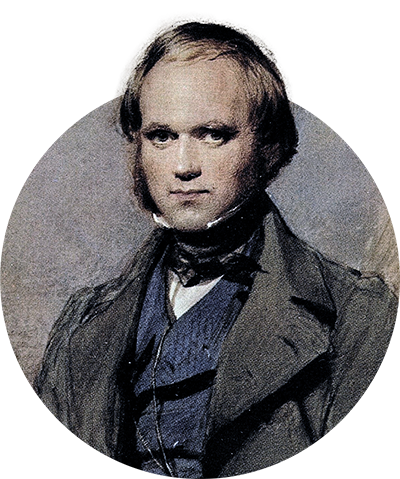
1833
This bird is commonly called the jackass penguin, from its habit, while on shore, of throwing its head backwards, and making a loud strange noise, very like the braying of an ass; but while at sea, and undisturbed, its note is very deep and solemn, and is often heard in the night-time. In diving, its little wings are used as fins; but on the land, as front legs. When crawling, it may be said on four legs, through the tussucks or on the side of a grassy cliff, it moves so very quickly that it might easily be mistaken for a quadruped. When at sea and fishing, it comes to the surface for the purpose of breathing with such a spring, and dives again so instantaneously, that I defy any one at first sight to be sure that it was not a fish leaping for sport.
– Charles Darwin, Voyage of the Beagle, 1833
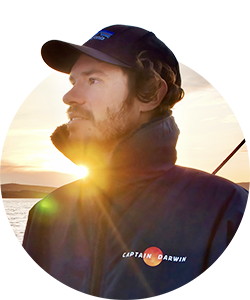
2023
At Volunteer Point, three penguin species reside: the Royal, the Magellanic, and the Gentoo. Interestingly, the king penguin colony did not exist during Darwin’s time; old records indicate its formation at the beginning of the 19th century.
Over the past few decades, Falkland Conservations’ counts reveal a relatively stable population trend for all three penguin species.
However, some species beyond Volunteer Point, like rockhopper penguins, experienced population crashes during the 20th century, predominantly due to industrial fishing practices.
Adding to the concern, climate change is progressively causing aridification in the Falklands, posing potential disastrous consequences for penguin populations.

1833
This bird is commonly called the jackass penguin, from its habit, while on shore, of throwing its head backwards, and making a loud strange noise, very like the braying of an ass; but while at sea, and undisturbed, its note is very deep and solemn, and is often heard in the night-time. In diving, its little wings are used as fins; but on the land, as front legs. When crawling, it may be said on four legs, through the tussucks or on the side of a grassy cliff, it moves so very quickly that it might easily be mistaken for a quadruped. When at sea and fishing, it comes to the surface for the purpose of breathing with such a spring, and dives again so instantaneously, that I defy any one at first sight to be sure that it was not a fish leaping for sport.
– Charles Darwin, Voyage of the Beagle, 1833

2023
At Volunteer Point, three penguin species reside: the Royal, the Magellanic, and the Gentoo. Interestingly, the king penguin colony did not exist during Darwin’s time; old records indicate its formation at the beginning of the 19th century.
Over the past few decades, Falkland Conservations’ counts reveal a relatively stable population trend for all three penguin species.
However, some species beyond Volunteer Point, like rockhopper penguins, experienced population crashes during the 20th century, predominantly due to industrial fishing practices.
Adding to the concern, climate change is progressively causing aridification in the Falklands, posing potential disastrous consequences for penguin populations.
Beaching at Volunteer Point
Landing at Volunteer Point! This morning, we left Stanley Harbor at 6:30 a.m., taking advantage of a beautiful weather window that should last two and a half days. In northwesterly winds, we first sail downwind to leave Port Williams, then we climb northwards in crosswinds, skirting the end of Berkeley Sound.
Arrived at the tip of Volunteer, we go around Uranie Rock: our objective is not very far, barely more than 5 nautical miles, but we are now facing the wind, which is freshening every minute. We sail upwind with great difficulty: the swell is well established and the spray falls on the cockpit to the rhythm of the waves.
Inquisitive imperial cormorants fly around our ship with disconcerting ease. Nice welcome. As we arrive north of Volunteer Beach, Cape Carysfort, located slightly further north, shelters us a little from the wind: we drop anchor.
Our goal is simple: land on the beach, just a few dozen kilometers from where Charles Darwin began his exploration of the Falkland Islands, and document the lives of penguins. Easier said than done ! Indeed the waves break on the beach and make the landing difficult. We put on our neoprene survival suits, and protect our filming equipment in waterproof bags.
Great good has taken us! The arrival is a bit tricky, but Alexis pilots the small inflatable boat with precision. Between two series of big waves, we finally arrive on the beach, a little wet, but without capsizing. The exploration can begin: beautiful encounters await us.
The king of penguins
Here is the king of penguins! The King Penguin (Aptenodytes Patagonicus) is the largest penguin in all of the Falklands, measuring around 1 meter in size. Volunteer Point is home to the largest colony on the entire island, with around 2,000 breeding pairs.
It is the most curious animal I have ever seen. He lets himself be approached very closely, and does not seem the least bit bothered by my presence. However, it should not be approached more than 5 meters: this is the rule for all wild animals in the Falkland Islands. On the beach, there are several hundred of them.
Some have just come out of the water, for it is in the ocean that they find their sustenance (they feed on fish), others are probably waiting to go there. Their wings have not allowed them to fly for a long time: they are used to move underwater at high speed. Most are perfectly fixed, sometimes alone or in small groups. Their surprising immobility makes them look like conspirators.
King penguins are mainly found on South Georgia, a large island located more than 1,500 kilometers to the east. The Volunteer Point colony is therefore rather small, but interestingly, it probably did not exist in Darwin’s time. The most recent evidence of its presence dates only from the 1950s: how did this bird get here? Scientists don’t know that very well.
Still, the population of Kings tends to increase from year to year: here is a rather welcome change between the time of Darwin and ours!
The gentoo penguin
This little Gentoo penguin is hungry! Continuing our exploration of Volunteer Point beyond the beach, we encounter a colony of gentoo penguins (Pygoscelis papua) including many young ones, probably born only a few weeks ago.
The oldest scientific description of this penguin dates from 1781, made by Johann Reinhold Foster, the naturalist who accompanied Captain Cook on his trip around the world, precisely in the Falkland Islands. Here is a species that Darwin probably encountered during his travels in the Falklands, even if he did not expressly described this species!
The Gentoos are monogamous, and it even has been observed that infidelity is punished by exclusion from the colony! Two eggs are laid each year, which are brooded by the father and the mother, who take turns each day for about a month until the eggs hatch. Newly born young penguins sport down for the first 3 months of their life (as seen in the first photo), then molt before they can go to sea.
Filming and photographing the life of the colony (as seen on the second photo) is absolutely fascinating. Sitting only a few meters from the colony, we observe the comings and goings of the adults who leave to feed at sea, then return to feed their chicks. On land, many of them cry out for their food, creating an amusing cacophony.
Tomorrow we will meet Amanda, a scientist who works at Falkland Conservation and whose job is to estimate the evolution of the population of Volunteer Point.
Amanda and the chick counting
Meet Amanda Keeper, an impassioned seabird scientist. Amanda has lived in the Falkland Islands for 8 years (as of today exactly!), first attracted by the study of albatrosses which are found in large numbers to the west of the islands. She now works as a seabird monitoring program coordinator at Falkland Conservation.
Armed with a simple mechanical counter, she walks around the different circles that make up the colony and carefully observes the chicks. One, two, three, four… up to more than 1,600! She does not do this work alone : she is accompanied by two volunteers, who work in exactly the same manner. At the end of the day, they compare their numbers, and if they don’t differ by more than 10%, the count is good.
This year, about 1,600 chicks are counted, which gives a valuable indication of breeding success. A figure that Amanda compares with those of the previous year: just over 1,500 in 2021. On all the Falkland Islands breeding sites, scientists observe a relatively stable or even slightly increasing trend for Gentoo penguins.
This work, which has been carried out for 34 years, allows Falkland Conservation to be attentive to the dynamics of the species and to react quickly if a sharp decline in the population is observed. An action plan would then be triggered, consisting of intensifying scientific research to better understand the causes of decline and proposing conservation actions (restoration of ecosystems, reduction of disturbances).
This is how scientists like Amanda, in addition to allowing us to better understand Nature around us, are also key players in the preservation of biodiversity!
Penguin versus gull
I wanted to share with you this photo, which depicts a very common scene on the colony of gentoo penguins (Pygoscelis papua). We see a dolphin gull (Leucophaeus scoresbii) facing an adult Gentoo feeding its chick.
The gull’s objective is simple: steal the food that the penguin is about to regurgitate to feed the baby bird. Here is a very striking example of kleptoparasitism, a somewhat barbaric word that designates the behavior of partial dependence of one species on another for its food supply.
Seagulls are great specialists in this field, and not only in the Falkland Islands! It is not uncommon to have your snack stolen on other countries’ coasts by species such as the herring gull or the black-backed gull.
A resident of the Falklands, Scoresby’s gulls are found not only on gentoo penguin colonies, but also alongside sea lions or rock shags.
The Magellanic penguin
Meet the Magellanic penguin, Spheniscus magellanicus! This penguin completes the collection of penguin species found at Volunteer Point, along with the king penguin and gentoo penguin.
In 1834, Darwin wrote of it: “This bird is commonly called the jackass penguin, from its habit, while on shore, of throwing its head backwards, and making a loud strange noise, very like the braying of an ass; but while at sea, and undisturbed, its note is very deep and solemn, and is often heard in the night-time.”
“In diving, its little wings are used as fins; but on the land, as front legs. When crawling, it may be said on four legs, […] it moves so very quickly that it might easily be mistaken for a quadruped. When at sea and fishing, it comes to the surface for the purpose of breathing with such a spring, and dives again so instantaneously, that I defy any one at first sight to be sure that it was not a fish leaping for sport.”
I can totally confirm all of his observations! I will add that it is a migratory bird, so it does not stay at Volunteer Point all year-round. It is found there during the breeding season, during which the couples dig a burrow in the ground, just above the beach, in which the chicks are born and then spend the first months of their life.
It is therefore necessary to be very careful where you put your feet when walking near the Magellanic penguins: the burrows could, despite being up to 2 meters deep, collapse under the weight of a visitor! Although not considered threatened by the IUCN, Falkland Conservation recently noted a slight decline in the population of Magellanic penguins in the Falkland Islands.
The Kings colony
Sunset over the colony of king penguins. After seeing them on the beach, we go to the colony of Aptenodytes Patagonicus, located a few minutes’ walk from the beach. The spectacle is breathtaking: thousands of them rub shoulders inside a circle about two hundred meters in diameter.
In fact, I hear the colony even before I see it. The cumulative sounds produced by the penguins create a loud cacophony. Their short, precise call, curiously similar to the sound of a flying drone, is mainly used to locate their partner and their offspring. Added to this are the sounds of altercations between males, which sometimes fight using their wings.
There are so many that I don’t know where to focus my attention. I don’t think I’ve ever seen such a large gathering of wild animals, except maybe some schools of fish or flocks of birds! The setting sun creates a grazing light that cuts the silhouette of each individual. I’m left speechless.
One Flew Over the Penguin’s Nest
Here is one of the rare aerial photos of the colony of Volunteer Point! While we were filming the king penguins, we received a visit from Derek Patterson, the warden of the place. Derek is interested in our image capture equipment, and more specifically our drone. Not that it is difficult to buy one here in the Falklands, but the difficulty is to obtain the authorizations to fly it.
As we are the first team to have these precious authorizations for 5 years, it is an unexpected opportunity to take photos of the colony seen from the sky! Indeed, it is the only 100% effective and precise method for counting the number of breeding pairs of king penguins, gathered in a compact group of several thousand individuals in which it is impossible to walk.
Before our eyes, the drone takes off, and gains altitude. I take this opportunity to take a nice photo of the colony under the sunset, before continuing to climb to take the photo Derek needs: an “overhead” photo, exactly in the center of the colony and camera pointing towards the ground.
Later, warm in his house, Derek starts counting. A tedious operation, since he will manually count… 2091 breeding pairs! A figure that has been constantly increasing since the beginning of the counts in the 1970s.
This good health of the king penguin colony, coupled with a stable or even slightly increasing population of gentoo penguins and Magellanic penguins, should not, however, hide worrying changes in the landscapes of Volunteer Point. Derek’s first concern is the progressive soil erosion linked to an increasingly intense drought. A clear sign that, despite good local management of biodiversity (including strict control of external disturbances such as tourism), climate change risks seriously impacting the health of ecosystems.



Donate
Help us spread the word about biodiversity by supporting our Patreon!
Social Networks
Follow Captain Darwin on Social Networks to follow our adventures!
Send an email
A question? Something to say? A word of encouragement? Send us an email!
© Captain Darwin 2023 - 1 rue des Senneurs - 29 900 Concarneau - FRANCE

